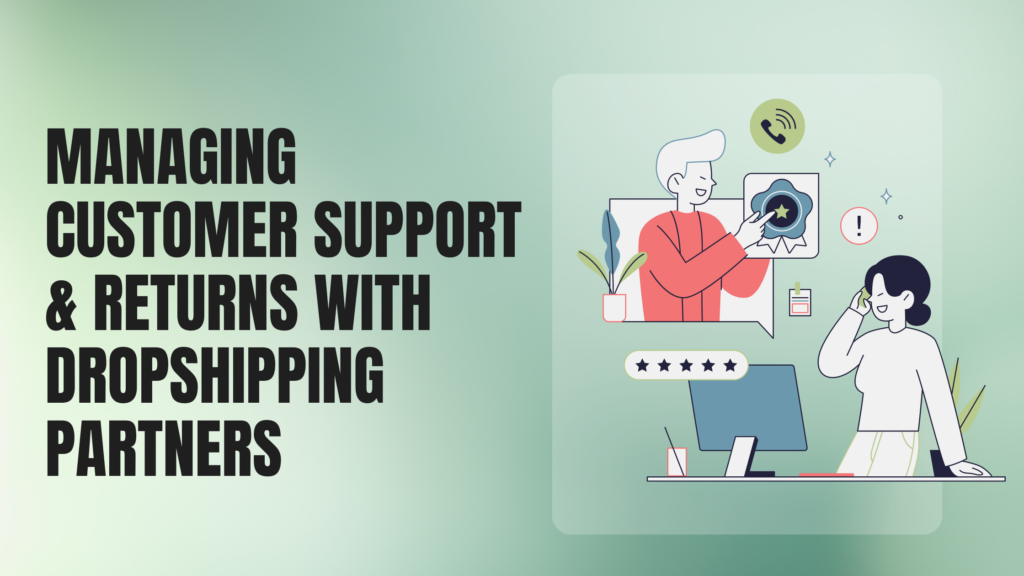Managing Customer Support and Returns with Dropshipping Partners
Dropshipping is a popular business model that allows entrepreneurs to sell products without the hassle of stocking inventory or handling shipping. Instead, they partner with third-party suppliers who take care of order fulfillment. While dropshipping offers many advantages, one challenge that arises is managing customer support and returns. In this blog, we will explore strategies for streamlining support and returns when using a dropshipping model, including tips for refunds, exchanges, and communicating with suppliers.
Understanding the Challenges of Dropshipping Returns
Dropshipping returns can be more complex than traditional ecommerce returns due to the lack of control over the fulfillment process. Without physical possession of the inventory, it becomes challenging to manage returns efficiently. However, understanding the reasons behind returns and implementing effective strategies can help streamline the process.
Creating an Effective Return Policy
A well-defined return policy is crucial for managing dropshipping returns. It sets clear expectations for customers and streamlines the returns management process. When creating your return policy, consider the following:
- Eligibility Conditions: Clearly state the conditions under which items can be returned.
- Returns Solutions: Specify the return solutions you offer, such as refunds, exchanges, or store credit.
- Return Time Frame: Communicate the duration of the return window and the expected refund/replacement timeline.
- Return Instructions: Provide clear instructions for customers to request a return.
Coordinating with Dropshipping Suppliers
Working with multiple dropshipping suppliers can complicate the returns process. Each supplier may have different return policies and procedures. Therefore, it’s essential to communicate with your suppliers and understand their return policies. Consider the following when coordinating with suppliers:
- Return Fees: Find out if suppliers charge restocking fees or shipping fees for returns.
- Return Process: Determine how suppliers handle returns, including whether they prefer returns to be shipped back to your warehouse or directly to them.
- Automating Returns: Explore the option of setting up an automated Return Portal that covers various conditions and settings for different suppliers.
Crafting a Clear and Informative Return Policy
A clear and easy-to-find return policy is essential for building customer confidence. Online shoppers often read the return policy before making a purchase. To create an effective return policy, consider the following:
- Clear Eligibility Conditions: Clearly outline the conditions under which items can be returned.
- Return Solutions: Specify the available return solutions, such as refunds, exchanges, or store credit.
- Return Time Frame: Clearly communicate the duration of the return window and the expected refund/replacement timeline.
- Additional Fees: Specify any additional fees, such as shipping fees or restocking fees.
- Easy-to-Follow Instructions: Provide step-by-step instructions for customers to request a return.
Handling Different Types of Returns
Dropshipping returns can occur for various reasons. Understanding the common types of returns and how to handle them can help streamline the process. Here are some common return scenarios and suggestions for managing them:
- Wrong Product or Size: Customers may order the wrong product or size. Facilitate easy returns and offer incentives for exchanges rather than just refunds.
- Product Description Mismatch: If a product doesn’t match its description, offer a satisfactory solution, whether it’s an exchange or a refund.
- Damaged or Defective Product: Take responsibility for compensating customers when they receive damaged or defective products. Consider offering an exchange or store credit as a solution.
- Late Delivery or No Longer Needed: Customers may request returns if the product arrives too late or if they no longer need it. Provide delivery estimates and real-time updates to manage customer expectations.
- Incorrect Product Sent: If a customer receives the wrong product, rectify the situation by sending the correct item or providing a refund.
Coordinating the Return Process
When a customer wants to return a product, it’s important to have a streamlined and efficient return process. Here’s a step-by-step guide for coordinating dropshipping returns:
- Customer Requests Return: The customer contacts you to request a return.
- Determine Return Reason: Find out why the customer wants to return the product.
- Assess Costs: Calculate the costs involved in the return, including shipping and restocking fees if applicable.
- Determine a Solution: Decide on a suitable solution, such as a full refund, product exchange, or store credit.
- Return Shipment: Instruct the customer to ship the product back to your supplier, noting the Return Merchandise Authorization (RMA) number.
- Supplier Confirmation: The supplier confirms the return and refunds your account or sends out a replacement product.
- Customer Refund or Update: Refund the customer or update them on the delivery of the replacement product.
Throughout the return process, maintaining a positive and polite relationship with both customers and suppliers is crucial.
The Importance of Streamlining Dropshipping Returns
Efficiently managing dropshipping returns has a significant impact on customer loyalty and sales. To streamline the process, consider the following strategies:
- Set Clear Expectations: Create a clear return policy that informs customers of what to expect.
- Coordinate with Suppliers: Communicate with your dropshipping suppliers to ensure a smooth return process.
- Effective Communication: Maintain open lines of communication with customers and strive to keep them satisfied.
- Utilize Return Management Systems: Consider using automated return management systems to track returns, send updates to customers, and manage shipping labels and fees.
By implementing these strategies, you can enhance customer satisfaction and establish a reputation for excellent customer support and efficient returns management in your dropshipping business.
Conclusion
Managing customer support and returns in a dropshipping business presents unique challenges. However, by understanding the complexities of dropshipping returns, creating an effective return policy, coordinating with suppliers, and streamlining the return process, you can successfully navigate these challenges. Remember to prioritize clear communication, efficient processes, and customer satisfaction to build a successful dropshipping business.





